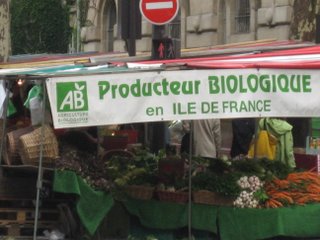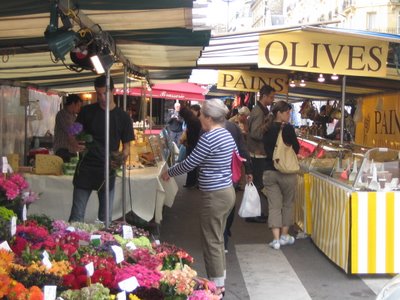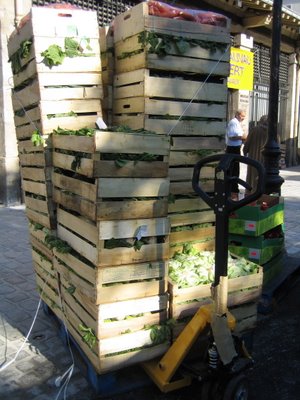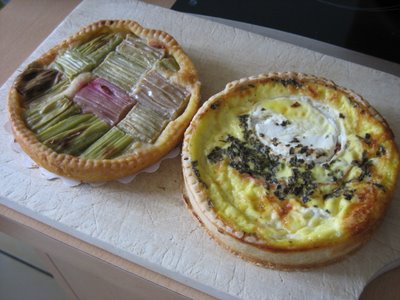Markets


Markets are one of the things that makes France very different from the US. On every day of the week except Mondays, there are markets happening somewhere in the city, selling everything you could possibly want in terms of food--fruits, vegetables, 


dried fruits, salt, honey, confiture (preserves), fresh fish and shellfish, 

meat, poultry, charcuterie (preserved meats), cheese, 
milk, yogurt, butter, herbs, spices . . . you get the picture.
Prepared foods, too.
A rhubarb tart and a savory goat cheese and thyme tart. 
On our fifth day in Paris we toured the Place d'Aligre market with David Lebovitz, a chef, cookbook author, and food blogger who leads culinary-focused tours of Paris. (www.davidlebovitz.com) Place d'Aligre is a bit off the beaten track, in the 11th arr. behind the Place de la Bastille. It was clear that David has spent a lot of time cultivating relationships with the vendors and shopkeepers on his tour. Everyone greeted us warmly, and we were given samples several places. 
We began at a bakery where we learned that the term "artisinal" is now controlled, and in order to advertise as an artisinal bakery, the bread and pastries must be baked on the premises. Croissants were invented to celebrate the end of Turkish rule by a French baker living in Belgium. The idea was that one was defiling the symbol of Turkey, the crescent, by eating it. These days, however, crescent shaped croissants are always made with margarine and thus are a little cheaper. If you want a real butter croissant, buy the rectangular ones.
The Place d'Aligre market is divided into indoor and outdoor vendors. The outdoor vendors stretch down the street for quite a ways, but the quality declines quickly as you leave the center area. While we were there, three kinds of plums were just peaking: mirabelles, which are so tiny and yellow with just a blush of red that they look like Ranier cherries; quetche, known in English as sugar plums are bruise-colored and oblong; and our favorites, Reine Claude. These are known as green gage plums in English and we've stopped growing them here because people wouldn't buy "green" plums. It's true that they are nearly emerald green, but unlike other plums they are sweet through and through with no sourness to the skin or the pit.
Chestnuts in their husks. Wild!

Carrots are often sold at the market still covered in the sand they grew in. They are supposed to stay sweeter that way.
We learned that beets are almost always sold cooked in France, and we saw many crates of cooked beets for sale. This practice originated during WWII because no one had enough fuel to cook beets in their homes. The government gave extra fuel to certain farmers who were licensed to cook beets and sell them that way at the markets.
It was also the season for cepes and chanterelles. They were everywhere. And even with the rotten exchange rate, they were preposterously inexpensive.


The indoor market contained the butcher (David made a point to ask if anyone was sensitive before we went in. The French are much more sanguine about seeing their meat in a recognizable animal form), several cheese sellers, some charcuterie vendors, a woman selling dried fruits, and many other stalls.
Dried Turkish figs on a string, or Miss Fig 2006
A charcuterie stand:
More cheese. . . 
We learned that "crottin" means turd, so these are sheep turds. Tasty ones, too.
We also learned that saying "brie" is like saying "cola." It's virtually meaningless. Brie was invented in the town of Meaux, about 60 miles from Paris, but the town never did anything to protect the name. The only "true" brie still comes from Meaux and it is made with raw milk thus unavailable in the US.
I wish I had a picture of the Brie de Melon. It is brie that is aged until it is hard and green. David swore that it was inedible unless dunked in coffee, and even then . . ..
This is salted butter. It's not a thing like the stuff you buy in the supermarket called salted butter. Instead, it is the sweetest, freshest unsalted butter through which run striations of crunchy fleur de sel. If you look closely you can see the salt crystals. Spread thickly on a fresh slice of baguette, it is it is a moment of pure bliss.
A happy girl and her market bag:

0 Comments:
Post a Comment
Subscribe to Post Comments [Atom]
<< Home